Reading Time: 15min

Welcome to our Carbon Finance Series! This first part sets the stage for understanding Carbon Project Financing. Make sure to read Part #2 on Pricing Carbon Credits and #3 Getting Your Project Funding-Ready.
Let's be honest: financing a carbon removal project can feel like navigating a maze sometimes. Between grant applications, equity fundraising, due diligence calls, and figuring out what investors actually want, it is easy to get overwhelmed - especially when as project developer you are busy trying to turn climate targets into real-world impact.
At Planet2050, we spend a lot of time speaking with partners deep in the trenches of carbon project development, whether it is for biochar, agroforestry, sustainable energy or blue ecosystem restoration.
What have we learnt? The technical side is challenging, yes. But raising capital is where many promising projects stall especially with changing market conditions and rules. But one thing remains clear: projects need smart, aligned capital - and they need it earlier than most investors are used to showing up.
This guide pulls together key concepts and insights, not just from our own experience, but from key reports and dozens of conversations with suppliers, investors, and buyers, to help projects make smarter decisions and accelerate climate action.
The journey from a promising climate initiative to a fully realized carbon credit project includes critical initial phases like feasibility studies, site preparation, equipment procurement, monitoring tools and the costs associated with carbon registration and certification services.
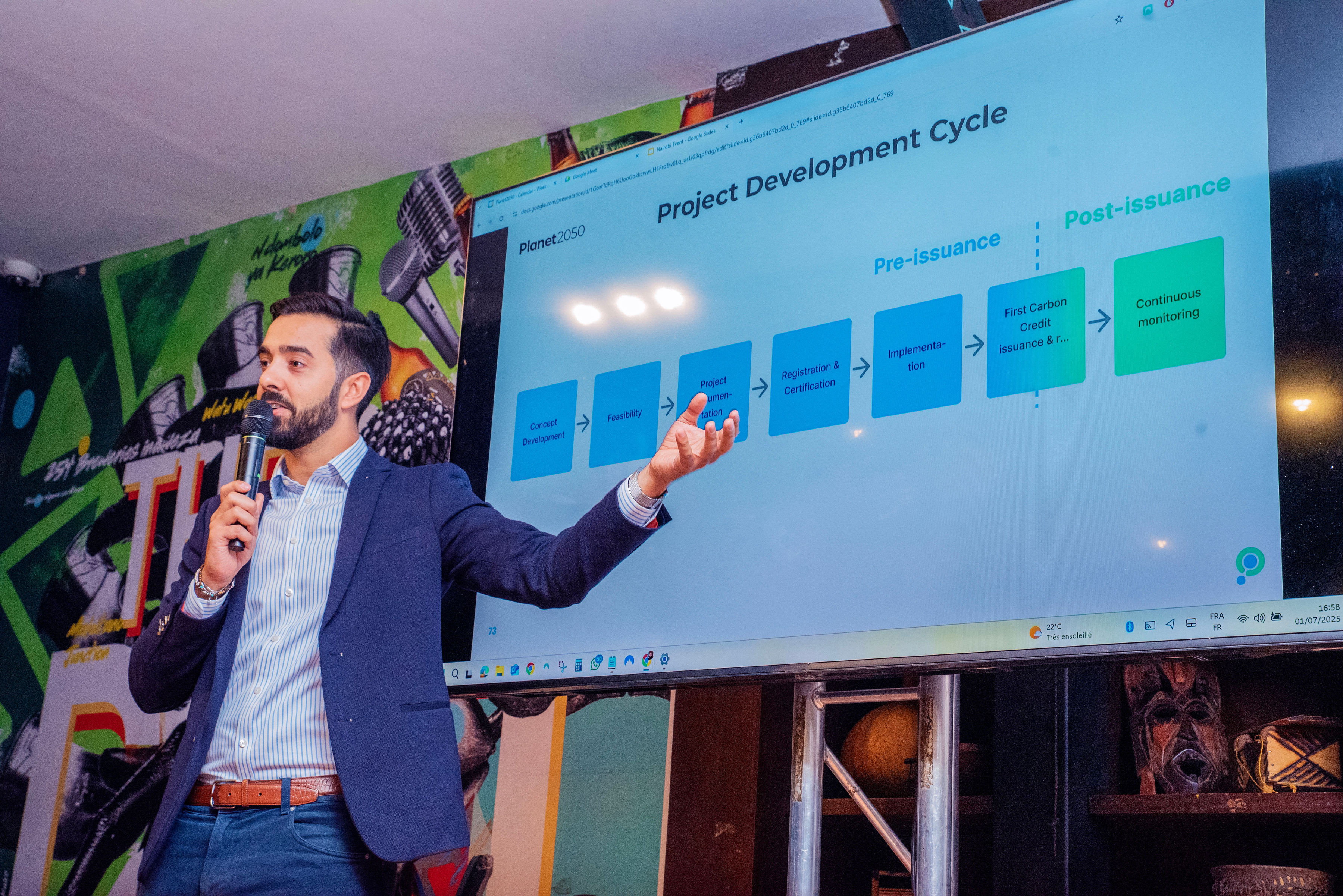
Project developers - the unsung heroes on the frontlines of climate action - frequently lack access to the Upfront Financing needed to kickstart their vital work. Many are forced to operate on limited resources and make difficult trade-offs until net cumulative cashflows (sum of costs - sum of revenues) becomes positive (break-even point) and their project becomes self-financed.
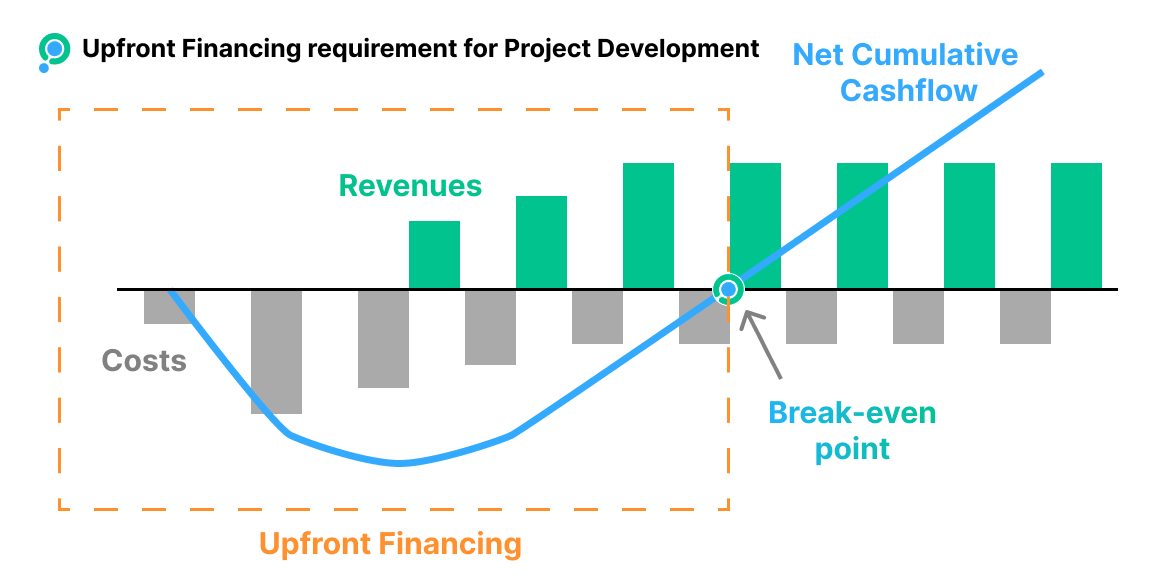
One might assume a straightforward solution: businesses eager to purchase carbon credits could simply bridge this financial gap.
However, the reality is far more complex.
The prevailing preference among many carbon buyers is for spot credits – credits that have already been issued (ex-post) and are immediately available.
This "buy now, pay now" mentality provides instant gratification but offers little in the way of foundational financial support for nascent projects.
While we are seeing many multi-year offtake agreements where buyers commit to purchasing future credits over time, these arrangements typically involve payments tied to credit delivery.
Although this welcomes assurance for developers and can improve financing terms, it rarely addresses the crucial need for early-stage capital. Couple that with market volatility, evolving compliance requirements like the integrity labels, and rising expectations for additionality, traceability, permanence, and third-party verification—and the landscape becomes increasingly complex.
True pre-payment, where buyers commit a portion or all of the anticipated credit value before the credits are even generated, remains rare, especially for projects in their higher-risk, early development stages.
This dynamic is not entirely unique.
The financing of any asset, from real estate developments to industrial solar farms, often follows a similar path: developers leverage their own equity and then seek additional capital from investors or banks through project finance, often in the form of debt with capital repayments according to an agreed schedule.
However, what works for established industries with predictable revenues and decades of operational experience simply doesn't translate seamlessly to the nascent carbon market.
Carbon projects represent a novel, growing investment area that demands tailored and at times project specific financial instruments.
Their inherent nature combines elements of climate science, market volatility, complex pricing mechanisms, and unique risk profiles.
Traditional public and institutional finance often proves either prohibitively expensive or entirely inaccessible for the majority of project developers in this field.
Understanding how carbon credits are bought and sold is key to navigating the market. Here's a breakdown of the primary transaction types:
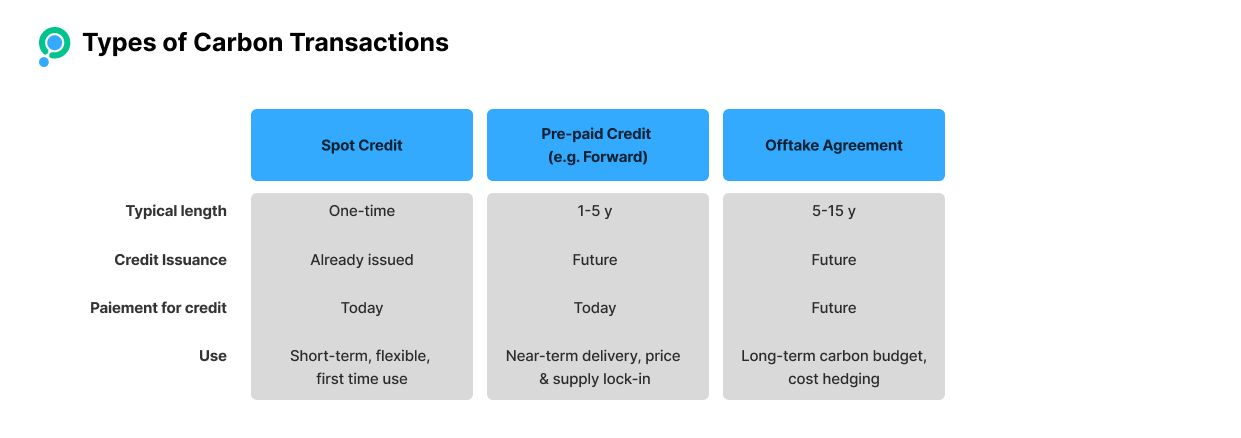
Spot Market Purchase: carbon buyers purchase immediately available, already-issued carbon credits. Think of "off-the-shelf" transactions. Here project developers can sell directly or through intermediaries (brokers, exchanges and marketplaces). Selling larger volumes usually means discounting prices but it also reduces credit transaction complexity and costs.
Offtake Agreement: Buyers commit to buying a specified volume of future carbon credits from a project, often over a multi-year period, typically with payment upon delivery when the credits are issued. While this is not directly contributing to funding, it provides long-term demand assurance, aiding project financing.
Pre-Payment Agreement: investors or buyers provide upfront financing to a carbon project developer today in exchange for future carbon credits, with carbon streaming or forward agreements (which we describe later). This crucial early capital helps projects get off the ground, though it comes with counterparty risk. Investors may take on more project risk but often gain access to credits at a potentially lower price or secure exclusive access.
When we talk about carbon credits, we usually think of them as ex-post credits. This means they're only issued and available on their original standard registry after the carbon reduction, avoidance, or removal has actually occurred and been independently verified. It's like getting a receipt after you've made a purchase.
However, there is another type: ex-ante credits. These credits are pre-issued by the certification standards themselves, on their official registry. They serve as a crucial transaction instrument designed specifically to facilitate upfront financing for projects.
You can think of them as being similar to "forward credits" in that they represent a future delivery, but they have the added benefit of being a formal, pre-issued instrument that can be traded today.
This allows project developers to secure the capital they need to get their initiatives off the ground, even before the carbon benefits are fully realized.
While there is no universal playbook, project developers can have access to a wider range of funding options.

Developer's Own Equity: funds invested by the project developer themselves, often starting via founders and initial shareholders.
Venture Capital (VC) / Private Equity (PE): external investors providing capital in exchange for ownership stakes. These investors may look for revenues later through dividends or exits.
Commercial Debt: traditional bank loans or specialized climate lending. Useful for later-stage operations, but requires a clear repayment plan and often collateral.
Mezzanine Finance: a hybrid of debt and equity, offering more flexibility than traditional debt but at a higher cost.
Pre-paid or « Forward » Credit Agreements: broad term for contracts to buy or sell carbon credits at a future date and price. The carbon credits are pre-purchased and paid for in advance, usually at a discount price to its expected future price at delivery, reflecting risks, pricing forecasts and cost of capital. They are typically one-off transactions involving a fixed volume of credits, with no long-term entitlement or ownership beyond the contracted amount.
Carbon Streaming: an emerging model used in other industries such as mining exploration, where investors provide upfront capital in exchange for the right to purchase a percentage of all future carbon credits generated by the project. The upfront capital can cover costs and additional payments are usually made following milestones achievement. The credits can then be purchased at delivery by the carbon streamer, often at a pre-agreed preferential price, creating a long-term revenue-linked arrangement rather than a single forward sale.
Grants: funds from NGOs, foundations or sometimes also private organizations. Non-dilutive and ideal for early feasibility studies, pilot phases, and projects with strong social or environmental co-benefits.
Philanthropy: direct donations from individuals or organizations passionate about climate solutions.
Microfinance: smaller loans tailored for community-based or small-scale projects, often with flexible terms.
Impact Funds: investment funds specifically focused on generating positive social and environmental impact alongside financial returns.
Crowdfunding: raising small amounts of capital from a large number of individuals, often via online platforms, appealing to broader public interest in climate action.
Public funding plays a pivotal role in accelerating the deployment of climate-related projects, particularly those involving nascent, less mature technologies or "first-of-a-kind" ventures that might be considered too risky for purely private capital in their initial stages.
This support can come in various forms:
Tax Credits: governments frequently offer tax credits to encourage investment in specific green technologies or activities. A prominent example in the U.S. is the 45Q tax credit, which incentivizes carbon capture, utilization, and sequestration (CCUS) projects under the Inflation Reduction Act by offering a credit per tonne of CO2 captured and stored or utilized.
Subsidies and Grants: direct financial contributions, such as subsidies or grants, are provided by national governments, dedicated climate funds, and research and innovation programs like Horizon Europe or EU LIFE. These funds can de-risk projects, cover a portion of capital expenditures, or support research and development that lowers future costs.
Concessional Loans: loans offered with more favorable terms (e.g., lower interest rates, longer repayment periods) than commercial loans, often from development finance institutions.
Public-Private Partnerships (PPPs): governments engage in PPPs where they take an equity share or provide loans, thereby sharing the financial risk and potential upside with private entities. This model has been successfully applied in various sectors, including the early retirement of coal-fired power plants, where public involvement helps mitigate the economic and social impacts of transitioning away from fossil fuels.
Development Bank Loan Guarantees: National and multilateral development banks (e.g., World Bank, African Development Bank) often provide loan guarantees. These guarantees reduce the risk for commercial lenders, making it easier and cheaper for green projects, especially in emerging markets, to secure financing from private banks.
Contracts for Difference (CfDs): CfDs are a crucial mechanism, especially for renewable energy projects. They provide developers with a stable revenue stream by guaranteeing a minimum price for the electricity generated. If the market price falls below this strike price, the government pays the difference; if it rises above, the developer pays the difference back to the government. This reduces price volatility risk for investors and makes projects more bankable.
In the context of energy or carbon markets, CFDs can also be used by governments to stabilize prices for producers (e.g., renewable energy projects) by guaranteeing a "strike price" and having producers pay back if market prices are too high, or receive a payment if market prices are too low. The UK has an active CfD scheme for renewables and carbon capture projects.
The landscape of climate finance is rapidly evolving with the rise of innovative financial instruments:
These are fixed-income instruments specifically designed to raise capital for projects with environmental benefits, such as renewable energy, energy efficiency, and sustainable waste management.
They have gained significant traction, allowing a wide range of organizations, from governments to corporations, to tap into a growing pool of environmentally conscious investors.
The increasing transparency and standardization around green bond issuance have bolstered their credibility and appeal.
This refers to the strategic use of public or philanthropic capital to mobilize additional private capital for sustainable development.
It's about combining different types of finance (e.g., concessional loans from development banks with commercial debt or equity) to make projects more attractive to private investors by reducing risks and improving financial returns.
This specific blended finance model, exemplified by organizations like Roots of Impact, involves providing a "top-up" payment or bonus to investors based on the achievement of predefined impact metrics.
This means that if a project performs exceptionally well in terms of its environmental or social impact, investors receive an additional financial incentive on top of their base return.
This model directly links financial returns to impact performance, creating impact-linked finance that rewards superior sustainability outcomes. It helps bridge the gap between financial viability and impact objectives, making truly transformative projects more appealing to a broader range of investors.
Carbon project developers strategically 'stack' various types of funding throughout their project's journey.
This is because the type of capital needed and where it comes from shifts significantly throughout a project's lifecycle—from an initial idea, through development and implementation, and into long-term operation.
This is illustrated in the visual below representing different needs and financing sources throughout the project development lifecycle.
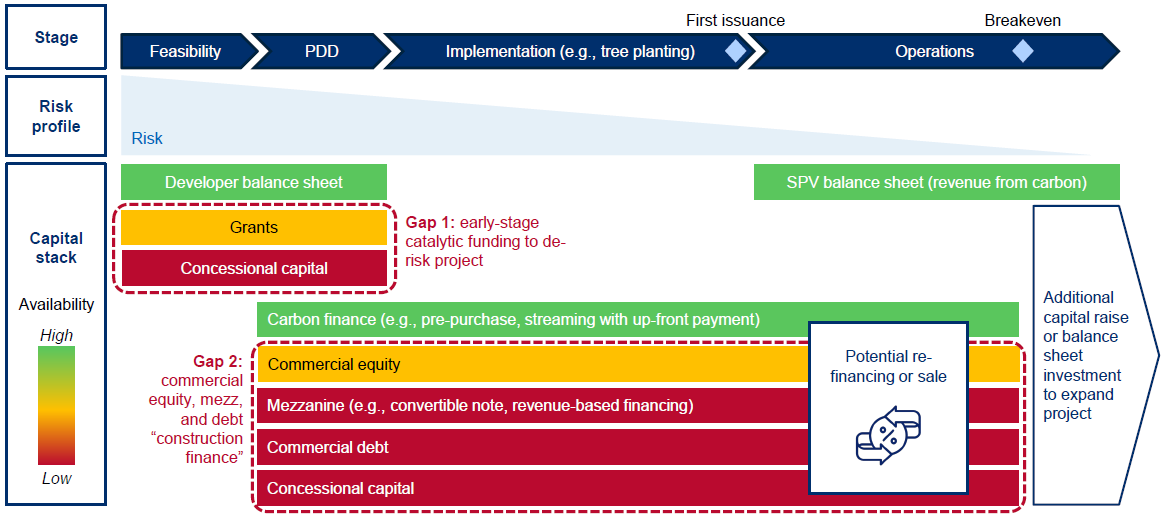
Source: Carbon Finance Masterclass - Crossboundary 2025
Individual equity-free Carbon Finance deals often come as combination of several instruments:
A loan + pre-payment: a developer secures a loan and a forward contract from the same buyers, repaying him both in capital and carbon credit.
An offtake Agreement with pre-payment component: a standard offtake agreement for future credit delivery is enhanced by an upfront pre-payment (e.g., 20% of the total value). This provides crucial early capital to the project while maintaining a long-term purchasing commitment. Advanced-Market Commitment programs such as Frontier or from the American Forest Foundation, as well as many businesses are frequently using such a mix.
A Carbon Removal observer (Isaac de Leon, CDR.fyi) reported in May 2025 several innovative carbon deal structure mixing different instruments:
Mati Carbon × J.P. Morgan (May 2025)
Senior debt on commercial terms, first-loss guarantee from the Schmidt Family Foundation.
Here philanthropy assumes the “new-tech” risk so a bank can lend like it’s a normal infrastructure deal.
MOMBAK × BNDES & Santander Brasil (Apr 2025)
R$100 m (≈ US $17.8 m) concessional loan from Brazil’s New Climate Fund; Santander’s guarantee unlocked disbursement.
This blends sovereign capital with private-bank Structure.
UNDO × Standard Chartered & British Airways (Sep 2024)
Working-capital loan collateralized by a multi-year BA offtake (>4 000 t CO₂); delivery & credit risk insured by CFC and carbon insurance broker WTW.
This is the first case of a commercial bank loan to a CDR start-up where insurance (not grants) absorbs the first-loss risk.
In another example announced in June 2025, Canadian company Key Carbon structured a $4.2 million investment based on royalty model to soil carbon company InSoil to scale operations across 1 million hectares of European farmland by 2026.
Burn Manufacturing also announced a ‘first-of-its-kind’ $80 investment in June 2025 with financing package comprising debt and performance-based grants. It was anchored by the Trade and Development Bank (TDB) Group and its concessional financing arm, the Trade and Development Fund (TDF), with support from the World Bank through the ASCENT program, a regional platform aimed at scaling access to clean energy.
Project developers have several strategic options for raising equity capital, depending on their organizational structure and the scale of their operations.
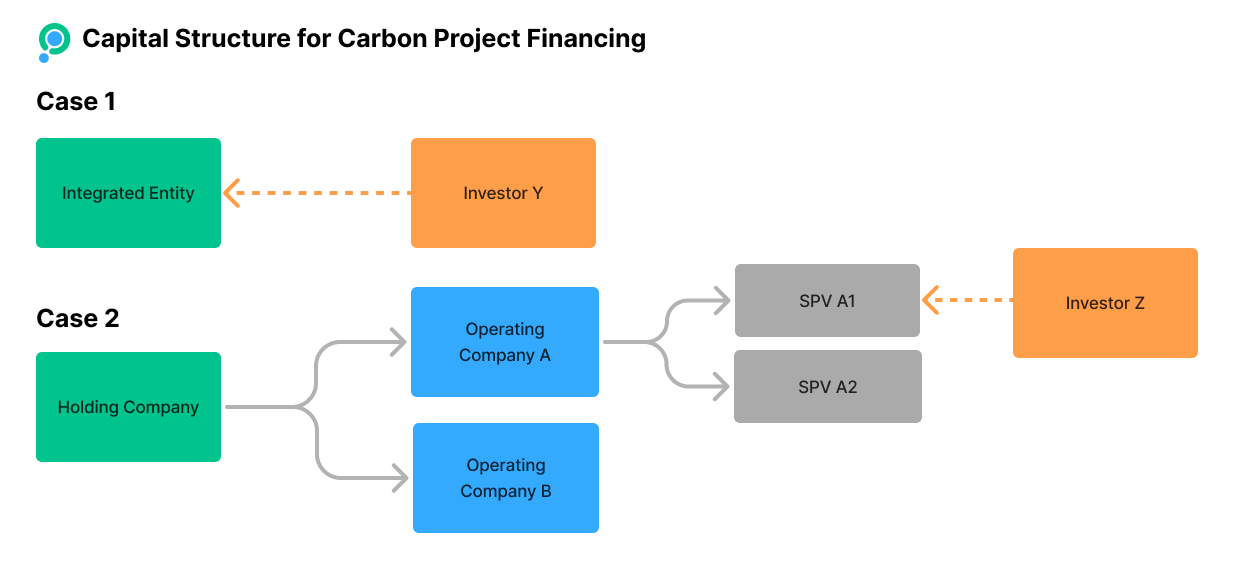
in cases where the project developer's organization and its carbon project(s) are essentially one and the same entity, equity is raised directly at this overarching organizational level. Think about a novel Carbon Removal startup financing its first project(s).
Here, investor Y is an equity investor who invests directly in this parent entity. Their capital supports not just the carbon project, but the overall growth and operations of the developer entity itself.
when a project developer is managing multiple projects across various project types or countries, they often establish separate legal structures for each, operating under a central holding or "mother" company.
Equity can then be raised at this top-tier HoldCo level, providing capital that can be allocated across its various subsidiaries and projects.
within a HoldCo structure, an OpCo may be established to control specific projects or geographic areas. Equity can be raised directly at this OpCo level, allowing for targeted investment in a particular segment of the developer's portfolio.
for individual projects, developers frequently create a dedicated SPV. This is a separate legal entity specifically formed to undertake and manage a single project.
Raising equity at the SPV level brings in capital directly for that specific project, often appealing to Investor Z who wants to fund a distinct, ring-fenced venture.
Planet2050 provides early capital to project developers in exchange for future carbon credits — using a combination of instruments of equity investment, carbon streaming agreements and forward contracts.
Through upfront financing, technical expertise, and close engagement with project developers, Planet2050 is building a high-quality portfolio — and a new infrastructure for the climate economy.
Project developers can contact us or directly apply through the Project Onboarding Form to submit their project for assessment.
For investors, this creates exposure to a new climate-linked asset class with long-term growth potential.
Planet2050 plans to make these investments accessible beyond traditional private finance, to a wider public, through an upcoming public listing in Europe.
Learn more at https://planet2050.earth/investors
__________________
Continue reading the Carbon Finance Series with Part #2 Pricing Carbon Credits and Part #3 Getting Your Project Funding-Ready
You can also subscribe to Planet2050 at https://planet2050.earth/newsletter